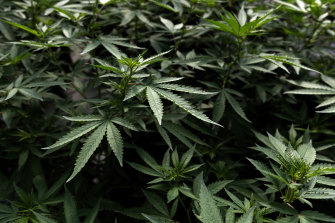By Francois Murphy
June 27, 2022 —
KEY POINTS
Legalising drug appears to increase regular use, UNODC says.
Cannabis on market getting stronger in terms of THC content.
Cocaine production, US opioid overdose deaths hit records.
Vienna: Places across the world that have legalised cannabis appear to have increased its regular use, while COVID lockdowns had a similar effect, raising the risk of depression and suicide, a UN report said on Monday.
Cannabis has long been the world’s most widely used drug and that use is increasing while the cannabis on the market is getting stronger in terms of its tetrahydrocannabinol (THC) content, the United Nations Office on Drugs and Crime (UNODC) said in its annual World Drug Report.

Marijuana plants grow in a greenhouse in Thailand, where recent legal changes mean it is no longer be a crime to grow and trade marijuana.CREDIT:BLOOMBERG
Various US states have legalised non-medical use of cannabis, starting with Washington and Colorado in 2012. Uruguay legalised it in 2013, as did Canada in 2018. Others have taken similar steps but the report focused on those three countries.
“Cannabis legalisation appears to have accelerated the upwards trends in reported daily use of the drug,” the Vienna-based UNODC’s report said.
While the prevalence of cannabis use among teenagers “has not changed much”, there had been “a pronounced increase in reported frequent use of high-potency products among young adults”, it said.
“The proportion of people with psychiatric disorders and suicides associated with regular cannabis use has increased.”

The legalisation of cannabis gummies has been linked with greater accidental use among children in the US. AND PETS
CREDIT:BLOOMBERG
The report said roughly 284 million people, or 5.6 per cent of the world’s population, had used a drug such as heroin, cocaine, amphetamines or ecstasy in 2020, the most recent data available. Of those, 209 million used cannabis.
“Periods of lockdown during the COVID-19 pandemic drove increases in the use of cannabis ... in 2020,” it said.
Cocaine production hit a record in 2020 and trafficking by sea is growing, it added, with 2021 seizure data suggesting an expansion outside the two main markets of North America and Europe into Africa and Asia.
RELATED ARTICLE

Drug reform
‘As legal as garlic’: High times in Thailand as marijuana is decriminalised
Opioids remain the deadliest drugs, it said, with fentanyl driving US overdose deaths to a new record: the provisional estimate for 2021 is 107,622.
Separate US analysis from the Institute on Taxation and Economic Policy shows that sales of cannabis generated more than $US11 billion in tax revenue for states and localities from 2014 through 2021. The research firm New Frontier Data projects the lawful weed business in the US will bring in sales of $US32 billion this year.
Before recent changes to the legality of cannabis it had been thought that more readily available marijuana might increase casual use by appealing to the so-called cannacurious. Surprising data show it’s also encouraged a rise in hardcore stoners. The US in 2019 saw a significant increase in the percentage of people over 26 who used marijuana in the previous month as well as in the share who used it daily or almost daily, according to an annual government survey. In Colorado, the first state to sanction recreational use, 15 per cent of those age 18 to 25 consumed weed daily, a figure twice as high as the national average.
According to a different report, 48 per cent of people in Colorado who used cannabis in 2019 did so on a daily or near-daily basis, up from 44 per cent in 2014. Canada, which authorised recreational use nationwide in 2018, has seen similar results. By the end of 2020, 20 per cent of people reported using marijuana in the previous three months, versus 14 per cent at the outset of 2018. Daily or near-daily use rose, too.
On the health effects of increased cannabis use, the drug can offer a benefit to those who previously bought the drug on the illicit market, given that laws require legitimate sellers to monitor their wares for contaminants. States with lawful recreational weed had fewer cases of vaping-related lung injuries, a 2020 study found.
On the downside, rates of cannabis use disorder in people age 12 to 17 grew 25 per cent more in states that legalised recreational marijuana than in those that didn’t, according to a 2020 study.
Since legalisation, Colorado has seen an increase in hospitalisations, emergency-department visits and poison-centre calls linked with marijuana exposure. Children who stumble upon a parent’s edibles are a particular cause of concern. In 2019 and the two years prior, there were a total of 4172 exposure cases nationwide in kids 0 to 9 years old, according to a study of calls to poison-control centres, which found that the rate was higher in states with sanctioned recreational use.
Reuters, Bloomberg
The report said roughly 284 million people, or 5.6 per cent of the world’s population, had used a drug such as heroin, cocaine, amphetamines or ecstasy in 2020, the most recent data available. Of those, 209 million used cannabis.
“Periods of lockdown during the COVID-19 pandemic drove increases in the use of cannabis ... in 2020,” it said.
Cocaine production hit a record in 2020 and trafficking by sea is growing, it added, with 2021 seizure data suggesting an expansion outside the two main markets of North America and Europe into Africa and Asia.
RELATED ARTICLE

Drug reform
‘As legal as garlic’: High times in Thailand as marijuana is decriminalised
Opioids remain the deadliest drugs, it said, with fentanyl driving US overdose deaths to a new record: the provisional estimate for 2021 is 107,622.
Separate US analysis from the Institute on Taxation and Economic Policy shows that sales of cannabis generated more than $US11 billion in tax revenue for states and localities from 2014 through 2021. The research firm New Frontier Data projects the lawful weed business in the US will bring in sales of $US32 billion this year.
Before recent changes to the legality of cannabis it had been thought that more readily available marijuana might increase casual use by appealing to the so-called cannacurious. Surprising data show it’s also encouraged a rise in hardcore stoners. The US in 2019 saw a significant increase in the percentage of people over 26 who used marijuana in the previous month as well as in the share who used it daily or almost daily, according to an annual government survey. In Colorado, the first state to sanction recreational use, 15 per cent of those age 18 to 25 consumed weed daily, a figure twice as high as the national average.
According to a different report, 48 per cent of people in Colorado who used cannabis in 2019 did so on a daily or near-daily basis, up from 44 per cent in 2014. Canada, which authorised recreational use nationwide in 2018, has seen similar results. By the end of 2020, 20 per cent of people reported using marijuana in the previous three months, versus 14 per cent at the outset of 2018. Daily or near-daily use rose, too.
On the health effects of increased cannabis use, the drug can offer a benefit to those who previously bought the drug on the illicit market, given that laws require legitimate sellers to monitor their wares for contaminants. States with lawful recreational weed had fewer cases of vaping-related lung injuries, a 2020 study found.
On the downside, rates of cannabis use disorder in people age 12 to 17 grew 25 per cent more in states that legalised recreational marijuana than in those that didn’t, according to a 2020 study.
Since legalisation, Colorado has seen an increase in hospitalisations, emergency-department visits and poison-centre calls linked with marijuana exposure. Children who stumble upon a parent’s edibles are a particular cause of concern. In 2019 and the two years prior, there were a total of 4172 exposure cases nationwide in kids 0 to 9 years old, according to a study of calls to poison-control centres, which found that the rate was higher in states with sanctioned recreational use.
Reuters, Bloomberg
No comments:
Post a Comment